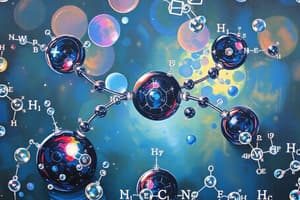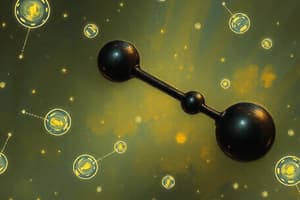Podcast
Questions and Answers
Which type of bond is formed when two p orbitals overlap head-on?
Which type of bond is formed when two p orbitals overlap head-on?
- Sigma (σ) bond (correct)
- Single bond
- Pi (π) bond
- Double bond
What is the role of an electrophile in a chemical reaction?
What is the role of an electrophile in a chemical reaction?
- Donates electrons
- Combines to form hybrid orbitals
- Forms pi bonds
- Accepts electrons (correct)
Why is carbon dioxide (CO₂) more reactive than methane (CH₄)?
Why is carbon dioxide (CO₂) more reactive than methane (CH₄)?
- CO₂ has a single bond
- CH₄ has a triple bond
- CH₄ has sp³ hybridization
- CO₂ has sp² hybridization (correct)
In orbital hybridization, what determines the shape and size of the hybrid orbitals?
In orbital hybridization, what determines the shape and size of the hybrid orbitals?
Which area of chemistry benefits from understanding bonding structure and reactivity?
Which area of chemistry benefits from understanding bonding structure and reactivity?
What role does orbital hybridization play in determining the reactivity of molecules?
What role does orbital hybridization play in determining the reactivity of molecules?
What role do bonding structures play in chemistry?
What role do bonding structures play in chemistry?
Which term best describes the arrangement of atoms in a compound?
Which term best describes the arrangement of atoms in a compound?
What determines the reactivity of a substance in chemistry?
What determines the reactivity of a substance in chemistry?
In general, which types of compounds tend to react with Lewis acids?
In general, which types of compounds tend to react with Lewis acids?
How does the reactivity of a compound change based on whether it is acting as an electrophile or a nucleophile?
How does the reactivity of a compound change based on whether it is acting as an electrophile or a nucleophile?
What is one key factor that influences the reactivity of compounds?
What is one key factor that influences the reactivity of compounds?
Flashcards are hidden until you start studying
Study Notes
Bonding Structure and Reactivity: Understanding Chemical Reactions through Orbital Hybridization
Bonding structures play a crucial role in determining the properties of various elements within chemistry. One of these properties is reactivity, which can be attributed to the bonding structure of an atom or molecule. This article will delve into the relationship between bonding structure, orbital hybridization, and chemical reactions, providing a comprehensive understanding of this essential aspect of chemistry.
Bonding Structures and Reactivity
Bonding structures refer to the arrangement of atoms in a compound. These arrangements dictate the types of bonds formed, including ionic, covalent, metallocenic, coordination complexes, and other noncovalent interactions. Different bonding structures result in varying levels of reactivity due to factors such as the strength of the bond, the presence of electron-donating or electron-accepting groups, and steric effects.
The reactivity of a substance depends on its ability to form new bonds with other species. In general, compounds tend to react with reagents having opposite characteristics. For example, Lewis acids typically react with Lewis bases, while Lewis bases react with Lewis acids. The reactivity of a specific compound also varies depending on whether it is acting as an electrophile or a nucleophile. An electrophile is an electron-deficient species that accepts electrons in a chemical reaction, while a nucleophile is an electron-rich species that donates electrons in a reaction.
Orbital Hybridization, Bonding, and Reactivity
Orbital hybridization is the process by which atomic orbitals combine to form new hybrid orbitals used in the formation of chemical bonds. There are three primary modes of hybridization: sp, sp², and sp³, each resulting from different combinations of orbitals. As shown in Figure 1, the sigma (σ) bond is formed when two p orbitals overlap head-on, while the pi (π) bond occurs when two p orbitals overlap sideways. The hybrid orbitals have identical energies, shapes, and sizes, allowing them to participate equally in forming chemical bonds.
Figure 1: Overlap of Orbitals
Hybridization plays a significant role in determining the bonding structure and reactivity of molecules. For example, consider the difference in reactivity between carbon dioxide (CO₂) and methane (CH₄). CO₂ has a double bond with an sp hybridization, while CH₄ has a single bond with an sp³ hybridization. The triple bond in CO₂ makes it more acidic and prone to undergo hydrolysis reactions, resulting in higher reactivity than the less polarized, singly bonded CH₄.
Applications of Bonding Structure and Reactivity in Chemistry
Understanding bonding structure and reactivity is essential in many areas of chemistry, including organic synthesis, medicinal chemistry, materials science, and environmental applications. By manipulating bonding structures and predicting reactivity patterns, chemists can design novel synthetic pathways, develop new drugs and polymeric materials, and address global challenges such as sustainable energy production.
In conclusion, the relationship between bonding structures and reactivity is fundamental to our comprehension of chemistry. By understanding how orbital hybridization influences the bonding structures of molecules, we can better understand their respective reactivities and apply this knowledge to advancements in various fields of chemistry.
Studying That Suits You
Use AI to generate personalized quizzes and flashcards to suit your learning preferences.




